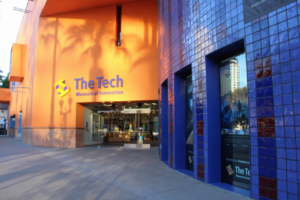In July, young adults joined Stanford lecturer in Mechanical Engineering David L. Jaffe for the Design and Assistive Technology Workshop in downtown San Jose’s Tech Museum. The workshop used hands-on projects to teach participants about assistive technology, or devices and services aimed at helping people with disabilities.
The program, part of the museum’s Social Innovators Workshop Series, was the first workshop of its kind at the Tech. According to Allison Berman, a program specialist at the Tech Museum who coordinated and developed the workshop, it was tailored to an audience with minimal experience in assistive technology and design. The first half of the workshop introduced students to assistive technology with a talk from Jaffe, while the second half centered around brainstorming, designing and fabricating a prototype of a device.
“I wanted to focus both on the general idea of teaching innovation and also to do a specific physical task that people could accomplish during that workshop and take home,” said Berman. “Because as much as we love to teach design, hands-on engineering is a major part of the Tech Studio.”
Jaffe, who teaches a course at Stanford called “ENGR 110: Perspectives in Assistive Technology,” says assistive technology isn’t limited to tangible devices and commercial products. Assistive technology also includes legislation, institutions and people from a multitude of professions that work to help people with disabilities and older adults.
Elderly people and people with disabilities were also invited to the workshop and interacted directly with the students, who worked on designing devices that could potentially solve an issue that their users struggle with.
“I wanted to have [a workshop] that focused on bringing empathy into the design process,” Berman said. “The goal here is to get people to think at the very beginning of their process about their user and to expand their ideal user into everybody, and not just sort of the middle section, the average user.”
The workshop’s aim: to design a device that anyone can use, whether or not they have disabilities.
The workshop sought to pique students’ interest in the field, encourage teamwork and expose participants to the design process.
“The Social Innovator Workshop Series is really about inspiring teens towards a career track they haven’t considered before,” Berman said.
The workshop emphasized the brainstorming and design concepts of assistive technology. Jaffe brought in a team of facilitators to assist the students with their brainstorming process, encouraging students to contribute any and every idea they had before shortlisting. He said creativity is essential to assistive technology — as is familiarity with the problems that older adults and people with disabilities face.
“If you design for an imaginary user,” Jaffe said, “your product will solve an imaginary problem.”
On a different note, able-bodied customers sometimes look at products designed to accommodate the disabled and think that they are paying for products from which they derive little value. Berman gave the example of pre-peeled oranges; many people tweeted that it was a product designed for lazy people. However, the product was useful to people with mobility issues and poor grip strength, among other disabilities.
“A workshop like this makes you think about that in the context of accessibility and the myriad of things that people around [us] are giving up that you never even think about,” Berman said.
Correction: An earlier version of this article used the terms “disabled and elderly” instead of “people with disabilities and older adults. This has been changed to respect the people-first identification of such groups. The Daily regrets this error.
Contact Aditi Chatradhi at aditichatradhi19 ‘at’ mittymonarch.org.


